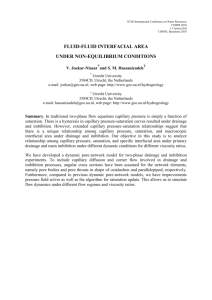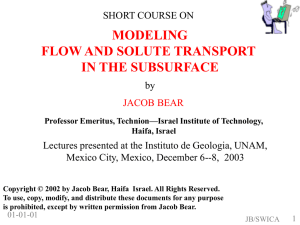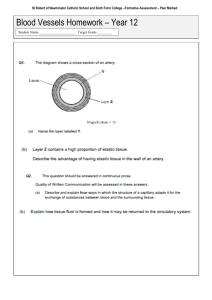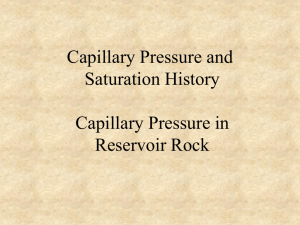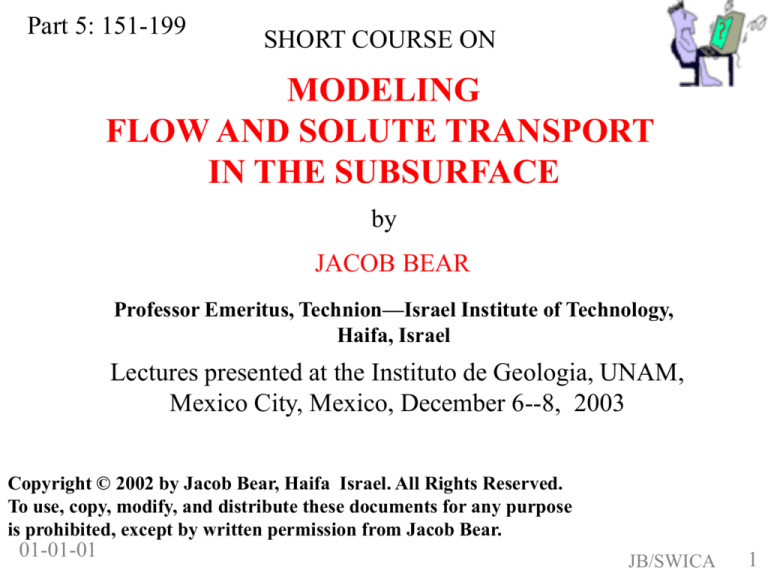
Part 5: 151-199
SHORT COURSE ON
MODELING
FLOW AND SOLUTE TRANSPORT
IN THE SUBSURFACE
by
JACOB BEAR
Professor Emeritus, Technion—Israel Institute of Technology,
Haifa, Israel
Lectures presented at the Instituto de Geologia, UNAM,
Mexico City, Mexico, December 6--8, 2003
Copyright © 2002 by Jacob Bear, Haifa Israel. All Rights Reserved.
To use, copy, modify, and distribute these documents for any purpose
is prohibited, except by written permission from Jacob Bear.
01-01-01
JB/SWICA
1
STATICS and DISTRIBUTION
OF PHASES IN THE
UNSATURATED ZONE
FLUID CONTENT at a point x and time t:
Vadose zone
volume of -fluid in REV
volume of REV
0 ,
.
( )
SATURATION at a point x and time t:
volume of -fluid in REV
S
volume of void space in REV
0 S 1,
01-01-01
S 1.
( )
With:
S .
JB/SWICA
151
We shall discuss:
The distribution of moisture (water) and other phases
(gas and possibly another liquid phase, which is not water)
within the unsaturated zone.
The movement of fluid phases in the unsaturated zone.
Mass balance equations and, eventually, complete models,
of flow of fluid phases within the unsaturated zone.
Both two and three fluid phases within the void space.
01-01-01
JB/SWICA
151
TWO OR THREE FLUID PHASES OCCUPY
THE VOID SPACE IN THIS ZONE.
How are the phases distributed within the void space in this zone?
How are phase pressures distributed within this zone?
CONCEPTS: MISCIBLE and IMMISCIBLE FLUID PHASES.
(In reality: very low miscibility)
The actual distributions and interphase interactions take place at
the microscopic level.
We need the macroscopic description, obtained by averaging.
A PHASE is defined as a homogeneous spatial domain that is
separated from other such domains by a well defined, sharp, physical
boundary (= INTERFACE).
01-01-01
JB/SWICA
152
HYDROSTATICS IN THE UNSATURATED ZONE
Vadose
Two immiscible liquids, or a liquid and a gas, that together occupy
the entire void space, are separated by a sharp interface. The
properties of the fluids at and close to this surface differ
significantly from those within the respective fluid bodies.
Interface
transition
Transition zone and (a sharp) interface between phases.
A surface between two liquids, between a liquid and a gas,
or between a liquid and its vapor.
01-01-01
JB/SWICA
153
Molecules of a fluid are attracted to each other by an attractive force.
Resultant attractive force on a molecule in the interior is zero.
A molecule belonging to the surface is subjected to a resultant
attractive force towards the INTERIOR of the liquid. As a
consequence of the pull towards the liquid, work must be performed
in order to increase the surface of the interface by bringing liquid
molecules from the interior to the interface.
Left alone, the interface always tends to contract to the smallest area
possible, seeking the shape that corresponds to MINIMUM
ENERGY, under the prevailing conditions e.g., the proximity of a
solid surface.
01-01-01
JB/SWICA
154
Actually, at the molecular level, no SHARP interface exists.
Instead, a transition takes place across a thin zone. The
transition zone is CONCEPTUALLY replaced, as an approximation,
by a sharp interface that is assumed to separate the two fluids.
SURFACE ENERGY, associated with this surface, per unit area,
equals the difference between the energy of all molecules (of both
phases) in the transition zone and the energy that they would have
possessed had they been in the interior of their respective domains.
Interface area can be increased by bringing molecules from the
interior. WORK must be done against the net cohesive force
among the molecules in the two fluids.
Energy is gained when the area of the interface is reduced.
01-01-01
JB/SWICA
155
SURFACE (or INTERFACIAL) FREE ENERGY
= work required to increase the area of an interface by one unit.
Molecules at the behave AS IF they belong to a thin, skin-like
membrane under tension, that adjusts its geometry to give the smallest
possible surface area. A real membrane behaves differently.
Interfacial tension within the "MEMBRANE" is measured as energy
per unit area (erg/cm2). The same surface tension is also measured
As FORCE PER UNIT LEGTH (dyne/cm) of a line within the surface.
The interfacial tension, gb = amount of work that must be
Performed in order to separate a unit area of substance from
substance b, or to increase their interface by a unit area.
01-01-01
JB/SWICA
156
For air (a) and water (w) at 200 C, gaw = 72 erg/cm2
(equivalently, as force unit length, gaw = 72 dyne/cm).
Surface tension, g = interfacial tension between an
-substance and its own vapor.
The magnitude of the surface tension, gb, depends on the
temperature, composition, and pressure of the fluids
CONTACT ANGLE, = angle between the solid
surface and the fluid-fluid interface, measured
through the denser fluid. It expresses the affinity of the
fluids for the solid.
01-01-01
JB/SWICA
157
HOWEVER, there must exist equilibrium ALSO normal
to the solid.
PREFERENTIAL WETTING
FOR ANY TWO FLUIDS AND A SOLID:
Wetting fluid.
90
0
Nonwetting fluid.
90
0
Additives, called surfactants tend to accumulate in the liquid close to
and at the interface. They reduce the interfacial tension, sometimes
significantly, and may alter contact angle
01-01-01
JB/SWICA
158
For THREE FLUID PHASES, When
a LENS of the intermediate wettability B-liquid will
be formed.
FILMS
In two-phase flow, molecular forces prevent complete drainage
of the wetting fluid from the void space. A thin film of adsorbed
wetting fluid will always remain on the solid in the void space.
The film may play a role in contaminant transport.
Solid may be L-fluid-wet, or a G-fluid-wet.
In the unsaturated (air--water) zone in the soil,
water is, usually, the wetting phase.
The air is the non-wetting fluid.
01-01-01
JB/SWICA
159
As the soil is being drained, water is drained from the void
space, and air fills up the evacuated space. As water leaves the
void space, the
LARGE PORE DRAIN FIRST!
As water is being drained, water--air interfaces
(menisci) are being formed. The radius of
curvature at every point on a meniscus depends
on the (local, microscopic) capillary pressure,
i.e., on the pressure jump across the meniscus, with this radius
becoming smaller as the capillary pressure increases.
To be discussed later
01-01-01
JB/SWICA
160
Pendular water
Insular air
As saturation decreases water leaves the larger pores, remaining in
the smaller ones, on the average!
Eventually, at a certain low saturation, the remaining water
occupies he "smallest" pores----- rings around grain contact
points---called pendular rings. Sometimes, a number of adjacent
pendular rings coalesce..
01-01-01
JB/SWICA
161
CAPILLARY PRESSURE and
RETENTION CURVES
The jump in the pressure between the nonwetting fluid (air) and the
wetting one (water) is called CAPILLARY PRESSURE.
A discontinuity in pressure exists across
the interface separating the two fluids.
This is the consequence of the interfacial
tension, which exists between any two adjacent phases
The difference between the pressure in the air (or in general, the
non-wetting phase), pair, and in the water (the wetting phase), pwater,
is called CAPILLARY PPRESSURE, p'c.
p pnonwetting pwetting ,
'
c
01-01-01
p pair pwater
'
c
Microscopic level!
JB/SWICA
162
Microscopic pressures as the
Radius of curvature
interface is approached from both sides at a point.
The magnitude of pressure jump depends on the
curvature and on the surface tension.
The interface is visualized as a (two-dimensional)
material body (surface) which has rheological properties of its own --It behaves as a `stretched membrane' under tension.
01-01-01
JB/SWICA
163
Force balance across a `stretched membrane'
The Laplace equation
Microscopic capillary
pressure.
'
c
1 1 2
p pn pw g wn * g wn .
r ' r '' r
r’,r’’: Two principal radii of curvature.
r* : Mean radius of curvature
01-01-01
1 2
1
*
r
r ' r '' JB/SWICA
164
Reminder: Immiscible fluids in a capillary tube.
Wetting
fluid
01-01-01
Nonwetting
fluid
'
2
g
cos
2
g
p
R
'
'
*
aw
aw
c
hc
, or hc
, r
*
w gR
w gr w g
cos
JB/SWICA
165
FLUID RETENTION RELATIONS
MACROSCOPIC CAPILLARY PRESSURE
Microscopic capillary pressure --- at a point on a
meniscus.
Macroscopic relations --- by averaging…..,but…..over surface
Within REV!
Static and dynamic equilibrium.
MACROSCOPIC CAPILLARY PRESSURE
n
w
pc pn pw .
In the unsaturated zone, the wetting fluid is water, while the
Non-wetting one is air. It is often ASSUMED that the air is at a
constant, atmospheric pressure, often taken as zero, i.e.,
n
a
w
01-01-01
pn pa 0. pc 0, pw 0. JB/SWICA
166
n
a
w
pn pa 0. pc 0, pw 0.
i.e., the pressure in the water is LESS THAN ATMOSPHERIC!
Often we use capillary pressure head
pw
hc
( 0)
w g
as variable.
In soil science, we often use SUCTION or MATRIC SUCTION
pw
w
w g
( 0)
Definitions should be employed only when the average water
density is constant.
a
When pa 0, suction may be defined by:
a
01-01-01
pa pw
w
w g
w
pc
w
w g
.
JB/SWICA
167
CAPILLARY PESSURE CURVES
In analogy to the microscopic Laplace formula, we may
write a macroscopic Laplace formula in the form:
Relationship AT THE MACROSCOPIC LEVEL, between
capillary pressure and saturations of two fluid phases.
LARGE PORES DRAIN FIRST!
What is a PORE?
Suggested definition
of a “pore”.
01-01-01
JB/SWICA
168
DRAINAGE AND IMBIBITION PROCESSES
AIR--WATER DISTRIBUTIONS:
Start with full water saturation.
Intermediate water saturations----FUNICULAR WATER
At low water saturation -- PENDULAR RINGS. Water is
discontinuous.
Trapped air upon rewetting.
INSULAR air saturation. Air is discontinuous.
Curvature of meniscus depends on size of pore. Hence, the
relationship between capillary pressure and saturation.
01-01-01
JB/SWICA
169
The relationship between the quantity of water in the void
space (within an REV), and prevailing capillary pressure is
expressed as CAPILLARY PRESSURE CURVE,
, pc = pc (Sw),
Or SUCTION CURVE:
(Sw)
In soil science: The RETENTION CURVE shows how much water
is retained in the soil by capillary forces (against gravity). Actually:
This is the capillary pressure curve.
The shape of the RETENTION CURVE depends on
pc pc ( S w , g aw (T , cg )).
pc pc ( S w ,T , cg )
01-01-01
:
T = temperature,
cg = concentration of species
in the fluids.
Simply: pc pc ( S w ) only.
JB/SWICA
170
TYPICAL CAPILLARY PRESSURE CURVES
DURING DRAINAGE
Point A indicates the threshold capillary pressure head. (= Bubbling
pressure, or air entry pressure), corresponding to the largest pore size .
Starting from a fully water saturated sample, , no air will penetrate
the sample until a critical (threshold) capillary head is reached.
01-01-01
JB/SWICA
171
The shape of the retention curve depends on the distributions
of pore sizes and shapes.
As water drainage progresses, some water remains even at very high
values of pc as isolated pendular rings and relatively immobile thin
films.
Notation:
Swr = IRREDUCIBLE or RESIDUAL WATER (or moisture)
SATURATION.
wr = RESIDUAL WATER CONTENT, with
w = Swr
Sar= RESIDUAL AIR SATURATION, when air saturation takes
the form of isolated air bubbles only.
IRREDUCIBLE ?
01-01-01
JB/SWICA
172
“IRREDUCIBLE” ?
Further reduction is possible by water evaporation &
air dissolving in water
01-01-01
JB/SWICA
173
Usually, use the term "retention
curve"
The retention curve is an expression of the pore-size distribution
of a soil. Recall Laplace formula:
2
pc pn pw * g aw
r
where r*
is a measure of the pores occupied by the wetting fluid.
pc1 ( S w )
r2*
*
pc 2 ( S w )
r1
For the same fluid,
(Scaling)
For the same porous medium, the scaling is by the fluid's interfacial
tension:
S w ( pc
01-01-01
fluids n1 , w1
) S w ( pc
fluids n2 , w2
)
g n w cos n w
b12
, b12 Scaling factor.
g n w cos n w
174
1 1
1 1
2
2
2
2
JB/SWICA
A tensiometer used for determining the moisture of the soil
in the field. Actually, the instrument determines the suction,
and then a retention curve (see below), prepared for the same
soil, is used to determine the moisture content.
Other methods: from cores,
Neutron attenuation device,
Electrical resistance, or dielectric cells,…
01-01-01
JB/SWICA
175
TENSIOMETER
The instrument used for measuring the capillary pressure
(or the suction) in the unsaturated zone.
A porous cup, made of unglazed
earthware, or ceramics).
The role:
Provide a contact between the water
in the tensiometer, but….
Recall: pc = 2gaw/r*
To prevent air from being
sucked through the porous cup
into the manometer, thus severing
the contact
01-01-01
JB/SWICA
176
DETERMINING THE RETENTION CURVE
Gradual drainage by producing suction.
Make sure that equilibrium is reached at
each step. Sometimes a very long time!
Range limited by entry value of porous plate.
The pressures are atmospheric or controlled.
01-01-01
JB/SWICA
177
ENTRAPPED AIR
Upon re-wetting, or imbibition, the capillary pressure curve,
pc = pc (Sw), differs from that obtained during drainage.
Upon re-wetting, or imbibition, the capillary
pressure curve, pc = pc (Sw), differs from that
obtained during drainage.
We start from a saturated soil sample (Sw = 1.0).
During DRAINAGE, we move to the left along
the drainage curve. If we stop the drainage
process, and switch to imbibition, i.e., to
wetting the sample (i.e., moving to the right),
we note two interesting phenomena:
01-01-01
JB/SWICA
178
…two interesting phenomena:
WE DO NOT MOVE BACK ALONG THE SAME
DRAINAGE CURVE.
Instead, we move, now from left to right, along a different curve.
WE DO NOT RETURN TO THE INITIAL POINT
OF FULL SATURATION
Although we return to pc = 0, we do not return to Sw = 1.0.
We have entrapped air that remains in the void space
and cannot be removed by the process of imbibition
01-01-01
JB/SWICA
179
HYSTERESIS and ENTRAPPED AIR
in a CAPILLARY PRESSURE CURVE
DRAINAGE AND IMBIBITION SCANNING CURVES:
01-01-01
JB/SWICA
180
HYSTERESIS:
Ink bottle effect. results from the shape of the pore space,
with interchanging narrow (throats) and wide passages.
We note the same meniscus curvature at different elevations.,
Raindrop effect is due to the fact that the contact
angle at the advancing trace of a water--air interface
on a solid surface is larger than at the receding one.
01-01-01
2
JB/SWICA
181
ANALYTICAL EXPRESSIONS FOR RETENTION CURVES.
METHODS BASED ON GRAIN-SIZE DISTRIBUTION.
Capillary pressure curve may be inferred from the pore size
distribution function via Laplace's capillary formula.
Effective (water) saturation
S w S wr
S w S wr
Se
, Sometimes : Se
1 S wr
1 S wr Sar
Brooks and Corey (1964)
p
b
for pc pb ,
Se pc
for pc pb .
1
= pore size distribution index
pb = bubbling pressure (minimum value of pc on a drainage capillary
01-01-01 pressure curve, at which a continuous air phase exists.
182
JB/SWICA
VAN GENUCHTEN (1978):
C
1
Se 1 ( A ) B
1
for 0,
for 0.
A, B, C ( = 1 - 1/B) = curve fitting coefficients
VAN GENUCHTEN (1980): The same as the 1978 formulation,
but
S w S wr
Se
1 S wr Sar
Sar = residual air saturation, due to entrapped air.
Swr = irreducible (= residual) water saturation.
01-01-01
JB/SWICA
183
SATURATION DISTRIBUTIONALONG THE VERTICAL
Homogeneous soil.
Deep water table.
No flow -- constant piezometric head,’
AIR_WATER system, = a,w.
By equating piezometric heads at points m =1,2:
hw,m zm
pw , m
g w
,
and
ha ,m zm
"No flow" means : hw,1 hw,2
Hence :
01-01-01
z2 z1
pc ,1 pc ,2
g ( w a )
and
pa ,m
g a
,
ha ,1 ha ,2
.
JB/SWICA
184
pc ,1 pc ,2
z2 z1
.
g ( w a )
Choose datum such that Sw=1.0 at z1=0.
Then: Sw,1=1.0 , Sa,1=0 , pc,1=0 , and with
a << w. Hence:
pc ,2
pc,2
z2
hc ,2 .
g ( w a ) g w
CONCLUSION:
The curves hc = hc (Sw) and z = z(Sw) above the water table,
pw = 0, with pa = 0, are the same.
01-01-01
JB/SWICA
185
SATURATION JUMP AT A POROUS MEDIUM
DISCONTINUITY
Assume a sharp boundary, in the continuum domain, between
porous media, I and II.
Two conditions at such boundary:
Continuity of fluxes
continuity of pressure.
Capillary pressure curve
and saturation
discontinuities
Continuity of pressure
p , I p , II , a, w
01-01-01
pc , I pc , II
JB/SWICA
186
SPECIFIC YIELD, y, and FIELD CAPACITY
A concept often used in modeling drainage of agricultural
lands and in discussing water table drawdown in phreatic aquifers
SPECIFIC YIELD: Volume of water drained from a soil column
of a unit horizontal cross-sectional area that extends from the soil
surface down to the underlying phreatic surface, per unit
drawdown of the latter.
A time-dependent quantity
SPECIFIC RETENTION, r
Same definition as “storativity
of a phreatic aquifer”.
y + r =
01-01-01
JB/SWICA
187
Moisture distributions.
Deep water table
Shallow water table
For deep water table:
water table's depths, d' at t’ and d'‘ at t’’.
1
'
y (t '' t ') h w ( z ', t ')dz '
h
0
d'
01-01-01
d ' h
0
( z '', t '')dz ''
''
w
JB/SWICA
188
d'
d ' h
1
'
''
y (t '' t ') h w ( z ', t ')dz ' w ( z '', t '')dz ''
h
0
0
1
h wr wr .
01-01-01
h
189
JB/SWICA
SPECIFIC YIELD depends on homogeneity of profile, time,
And depth to water table.
Usually, specific yield is used to indicate the volume of water
drained during a sufficiently long time following a rise or drop in
phreatic surface . Then:
y wr , wr Swr .
In reality, equilibrium conditions will rarely, if ever, be reached.
FIELD CAPACITY: In soil science, approximately, the water content
remaining in a unit volume of soil after gravity drainage has
(practically) ceased.
Depends on sample elevation. Hence, useful when soil is located both
sufficiently high above a water table, and at a sufficient depth below
ground surface.
01-01-01
JB/SWICA
190
THREE FLUID PHASES
Background:
NAPL
LNAPL
DNAPL
01-01-01
JB/SWICA
191
THREE FLUID PHASES
AIR, WATER and NONAQUEOUS PHASE LIQUID (NAPL)
Subsurface contamination (leaks, spills) by:
hydrocarbons,
organic solvents.
volatile components.
components that dissolve in water.}
FREE PRODUCT
Small, medium and large spills
Sharp (microscopic) interfaces between the NAPL and both the
gas and the water within the void space.
LNAPL….. Lighter than water, e.g.,gasoline.
DNAPL (HNAPL)….. Denser than water, e.g. chlorinated solvents.
NAPL components dissolve in water in small (ppb) (yet dangerous)
quantities. Solubility of TCE (= Trichloroethene), aprox.
1.1 x 106 ppb at 20oC.
01-01-01
JB/SWICA
192
THREE PHASE CAPILLARY PRESSURE RELATIONS
For any set of three phases and a solid:
Wetting phase (w).
Intermediate wetting phase (o, or i).
Nonwetting phase (n).
(A mineral surface (with a high organic content) may be oil-wet.}
SATURATIONS:
Sw + So + Sa = 1.0
Oil---A nonaqueous phase---is the intermediate wetting phase.
Air---a gaseous phase---is the nonwetting phase. It tries to be as far
as possible from the solid.
01-01-01
JB/SWICA
193
CONCEPT OF CAPILLARY PRESSURE EXTENDED TO
THREE FLUID PHASES.
LAPLACE's FORMULA for water(w), oil(o), air(a).
pcow, pcao = oil--water & air—oil capillary pressures.
r*ow, r*ao = radii of air--water & air—oil interfaces.
gow, gaw = interfacial tensions.
Capillary pressure curves depend on pore-size distribution.
01-01-01
JB/SWICA
194
CUMULATIVE PORE-SIZE DISTRIBUTION FUNCTION
R* = R*(r*): = cumulative fraction of the void space with
pores smaller than r*.
Disregarding hysteresis and fluid entrapment:
*
*
row
row
( S w ) r * ( R*)
*
*
raw
raw
( S w ) r * ( R*)
S Sw
S Sl
,
,
Sl S w So total liquid saturation.
r*ow is a function of Sw only, since all pore with radii smaller
than r*ow are assumed to be occupied by water only.
01-01-01
JB/SWICA
195
All pore with radii smaller than r*ow
are assumed to be occupied by water only.
All pore with radii smaller than r*ao
are assumed to be occupied by both water and oil.
With respect to air, the two liquids behave as a single wetting fluid.
2
pcow ( S w )
g ow ,
r * ( R*) S S
w
2
pcaw ( Sl )
g aw ,
r * ( R*) S S
l
CONCLUSION:
For a given pair of fluids, Sw is a function of pcow only, and
Sl is a function of pcaw only.
In a three-fluid phase system, if Sw( pcow) is independent of air pressure,
it should be IDENTICAL to the function Sw( pcow) for a two-phase,
oil-water, system.
01-01-01
JB/SWICA
196
Repeat:
In a three-fluid phase system, if Sw( pcow) is independent of air
pressure, it should be IDENTICAL to the function Sw( pcow)
for a two-phase, oil-water, system.
pcow S pcow ,
III
II
Sl pcaw Sl pcaw .
S
III
w
II
w
II, III denote 2- and 3-phase systems
01-01-01
JB/SWICA
197
VERTICAL EQUILIBRIUM SATURATION DISTRIBUTION
OF THREE FLUID PHASES
Vertical-equilibrium (VE-) hypothesis
01-01-01
JB/SWICA
198
For a sufficiently large (one time) spill of LNAPL, such that
the percolating LNAPL will reach and accumulate on an
underlying water table in the form of a floating lens that
spreads out laterally.
The lens will also move in the direction of the sloping water table.
The assumption that the flow of both the LNAPL and water are
essentially horizontal is equivalent to stating that the
vertical pressure distribution within each phase is hydrostatic.
01-01-01
End of part 5
199
JB/SWICA
Copyright © 2000 by Jacob Bear, Haifa Israel.
All Rights Reserved.
MODELING
FLOW AND SOLUTE TRANSPORT
IN THE SUBSURFACE
by
JACOB BEAR
WORKSHOP I
Part 5:slides 150-199
01-01-01
JB/SWICA 150
01-01-01
JB/SWICA

